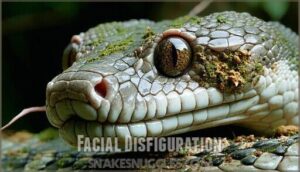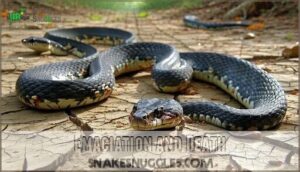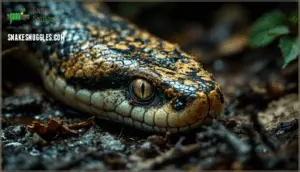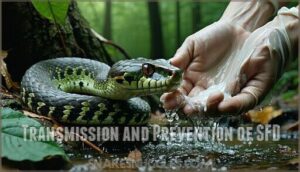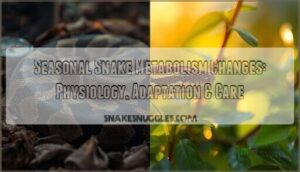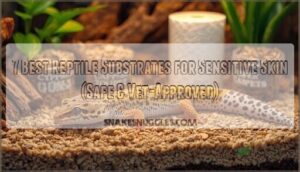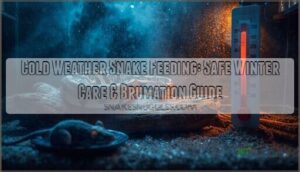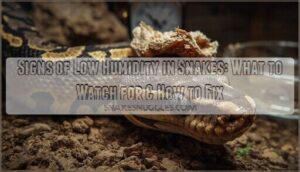This site is supported by our readers. We may earn a commission, at no cost to you, if you purchase through links.
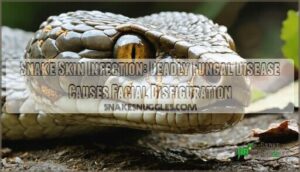
This snake skin infection and facial disfiguration stems from the Ophidiomyces ophiodiicola fungus, which creates crusty, ulcerated scales and grotesque facial swelling that can literally reshape a snake’s head.
While it sounds terrifying, SFD doesn’t jump to humans or pets – but it’s devastating wild snake populations across North America.
The infection spreads through contaminated environments and stressed snakes, causing behavioral changes before the visible horror show begins.
Understanding the warning signs could help you spot trouble early and protect local ecosystems.
Table Of Contents
- Key Takeaways
- Snake Skin Infection Symptoms
- Causes of Snake Fungal Disease
- Transmission and Prevention of SFD
- Impact of SFD on Snake Populations
- Reporting and Handling SFD Cases
- Frequently Asked Questions (FAQs)
- What does a skin infection look like on a snake?
- What does snake fungal disease look like?
- Can humans get snake fungal disease?
- Do snake skins have diseases?
- How does SFD affect snake feeding behavior?
- Are there any resistant snake species to SFD?
- What role does climate play in SFD spread?
- How long does recovery from SFD take?
- Can environmental management reduce SFD cases?
- How long does SFD take to kill snakes?
- Conclusion
Key Takeaways
- You can’t catch snake fungal disease from infected snakes – it’s completely harmless to humans and pets, so don’t worry about transmission through handling or proximity.
- Look for crusty, thickened scales and facial swelling as key warning signs – these symptoms indicate serious infection that can lead to death within 90 days if untreated.
- Report any sick or dead snakes with suspicious symptoms to your state wildlife agency immediately – your observations help researchers track this devastating disease that’s crashing snake populations.
- Practice basic hygiene when handling wild snakes by wearing gloves and washing hands thoroughly – this prevents you from accidentally spreading the fungus to healthy snake populations.
Snake Skin Infection Symptoms
If you spot a snake with thick, crusty patches on its scales or strange bumps under its skin, you’re likely looking at Snake Fungal Disease in action.
These telltale signs can quickly escalate from minor skin issues to severe facial deformities that make the snake look like something from a nightmare.
Snake fungal disease transforms healthy reptiles into grotesque shadows of their former selves.
Crusted or Ulcerated Scales
Disfigurement creeps across your snake’s body when snake fungal disease strikes.
Crusty scales and skin lesions snakes develop signal serious trouble ahead. These skin infection symptoms start small but worsen fast.
Scale morphology changes dramatically as lesion progression accelerates. Infection severity determines your pet’s treatment response.
Even after recovery, scarring effects may remain permanently on affected areas.
Nodules Under The Skin
When you spot lumps beneath your snake’s skin, you’re looking at nodules that signal fungal invasion.
These bumps vary in nodule size and nodule location, appearing anywhere from the head to tail.
Nodule composition includes infected tissue and fungal material, while nodule progression shows how the snake skin infection spreads.
Understanding these underlying mechanisms helps identify snake fungal infection early, before crusty scales and skin lesions snakes develop.
Facial Disfiguration
You’ll notice facial disfiguration develops as SFD progresses, causing scale thickening and crusty lesions.
Jaw misalignment and nares occlusion create feeding difficulties and breathing problems.
Vision impairment occurs when swelling affects the eyes.
This condition, known as snake fungal disease, has been observed across the Midwest and Eastern United States since 2000.
While facial disfiguration repair isn’t possible in wild snakes, facial reconstruction surgery might help captive specimens.
This facial deformity correction requires veterinary expertise to address severe facial disfiguration causes.
Emaciation and Death
When snake fungal disease strikes, it’s like watching a slow-motion tragedy unfold.
The fungal infection creates a vicious cycle where energy expenditure skyrockets as snakes struggle to fight off the disease.
Snake fungal disease turns these predators into victims, burning through their energy reserves as they battle an infection they can’t outrun.
Nutritional deficiencies develop rapidly, leading to severe emaciation that weakens their already compromised immune systems.
Disease progression accelerates mortality factors, often resulting in organ failure.
This devastating combination contributes substantially to snake mortality and overall population decline.
Behavioral Changes
Beyond the physical toll of snake fungal disease, you’ll notice striking behavioral changes in affected snakes.
Lethargy signs become apparent as infected snakes struggle with basic movements and hunting impact becomes severe.
Some snakes show hyperactivity causes from stress, making them restless and exposed to danger.
Social behavior shifts dramatically, with snakes avoiding normal interactions.
Basking changes occur as they seek different temperature zones.
These snake behavior modifications signal that snake fungal infections are progressing, requiring immediate attention for facial disfigurement support and thorough care.
Causes of Snake Fungal Disease
Understanding what causes snake fungal disease helps you recognize why this devastating condition spreads so rapidly through wild populations.
The primary culprit is Ophidiomyces ophiodiicola, a specialized fungus that targets snake skin, but stress hormones, environmental changes, and secondary infections all work together to create the perfect storm for this deadly disease.
Ophidiomyces Ophiodiicola Fungus
This troublemaker Ophidiomyces ophiodiicola targets snake skin through complex virulence factors and genetic diversity.
Its environmental persistence makes control challenging, while antifungal susceptibility varies across populations.
Understanding this pathogen’s fungal morphology helps researchers develop treatments for devastating skin lesions and facial disfiguration in snake fungal disease.
Role of Stress Hormones
How do stress hormones sabotage your snake’s defenses against snake fungal disease?
These chemical messengers trigger immune suppression and corticosteroid effects, weakening resistance to skin lesions and facial disfiguration.
Captivity stress and environmental stressors create perfect conditions for infection, making entire populations vulnerable to this devastating snake skin infection.
Environmental Factors
Due to climate change and habitat loss, environmental factors create perfect storms for snake skin infection.
Water pollution and soil contamination weaken your snake’s immune system, while seasonal cycles disrupt natural behaviors.
These environmental factors stress snakes, making them vulnerable to fungal disease that causes facial disfiguration.
Environmental contamination basically rolls out the red carpet for infections.
Other Fungi, Bacteria, or Viruses
While SFD typically stems from Ophidiomyces ophiodiicola, you’ll find that polymicrobial infections create a perfect storm for facial disfiguration.
Secondary infections from bacteria like Pseudomonas or fungi such as Penicillium exploit compromised skin barriers, leading to devastating co-infection effects.
Reptiles can also develop infections due to opportunistic commensals.
- Immune suppression from viral infections makes snakes vulnerable to opportunistic pathogens
- Pathogen interactions between multiple microbes accelerate tissue damage and necrosis
- Fungal pathogens beyond SFD can mimic symptoms, complicating diagnosis
Transmission and Prevention of SFD
You’ll encounter snake fungal disease through direct contact with infected snakes or contaminated environments where the fungus persists in soil and water.
Prevention requires proper hygiene practices like washing hands thoroughly and wearing gloves when handling snakes or working in areas where infected animals have been present, which involves prevention.
Spread by Infected Snakes
Infected snakes become walking disease factories, spreading Ophidiomyces ophiodiicola through direct contact with healthy snakes.
When they shed contaminated scales or slither across surfaces, they create an environmental reservoir of fungus. Soil contamination occurs wherever infected snakes travel, making disease transmission inevitable.
Human activities can accidentally spread this snake skin infection further. This is because contaminated soil spreads the disease to new locations.
You’ll want to avoid handling wild snakes showing facial disfiguration from snake fungal disease.
Environmental Contamination
Contaminated environments act like invisible traps for snakes seeking shelter.
Soil contamination, water pollution, and habitat degradation create fungus reservoirs where Ophidiomyces thrives.
Human tracking spreads spores between locations on boots and equipment.
Environmental factors like poor drainage worsen snake contamination risks.
Environmental changes from development increase exposure.
Protect snake environments by avoiding environmental impact through careful habitat management.
Human and Pet Safety
Good news—you won’t catch snake fungal disease from infected snakes, and neither will your pets.
Here’s what keeps everyone safe:
- Pet Exposure: Cats, dogs, and birds can’t contract SFD from snakes
- Children’s Safety: Zero zoonotic potential means kids stay protected
- Safe Distancing: Avoid handling wild snakes showing symptoms
- Hygiene Practices: Wash hands after any snake contact
The provided list outlines key safety measures to prevent the spread of snake fungal disease, emphasizing protection for both humans and animals.
Handwashing and Gloves
Beyond protecting yourself from snake fungal disease, proper technique matters when handling wildlife.
You’ll need quality glove material like nitrile to prevent cross-contamination between infected and healthy snakes. Consider using durable nitrile gloves for enhanced protection.
Always wash your hands thoroughly after removing gloves, using soap and warm water for at least twenty seconds. Smart disposal methods help maintain public awareness about preventive measures.
- Follow these snake handling protocols: Use dedicated gloves, practice proper snake hygiene, and sanitize equipment to stop disease spread through cleanliness habits.
Coexisting With Snakes
Beyond proper hygiene, creating Safe Habitats means understanding snake coexistence in your yard. These reptiles aren’t looking for trouble—they’re hunting rodents and staying cool.
Smart snake handling starts with Snake Education: remove brush piles, seal gaps, and maintain awareness. Responsible Encounters happen when you respect their space. Conservation Awareness and Fear Mitigation go hand-in-hand—most snakes won’t bother you if you don’t bother them.
Practice preventive measures for everyone’s safety.
Snake Habitat
Safe Yard
Snake Awareness
Human Safety
Impact of SFD on Snake Populations
When SFD hits snake populations, you’re looking at serious ecological trouble that ripples through entire ecosystems.
This fungal disease doesn’t just kill individual snakes—it crashes populations and throws food webs completely out of balance, causing serious ecological issues.
Population Declines
Several snake populations face species vulnerability from snake fungal disease, with Ophidiomyces ophiodiicola driving population decline rates up to 40%.
This snake disease impact threatens genetic diversity and ecosystem health as infected populations can’t sustain themselves.
The food web suffers when snake numbers drop, creating ripple effects that demand urgent conservation impact strategies.
Ecosystem Disruption
When snake fungal disease causes population decline, it creates a domino effect that disrupts entire ecosystems.
Think of snakes as nature’s pest control—without them, you’ll see dramatic changes unfold:
- Prey surges overwhelm local habitats as rodent populations explode
- Predator shifts occur when other animals compete for dwindling food sources
- Food webs become unstable, affecting multiple species connections
- Ecosystem health deteriorates, impacting overall habitat balance and biodiversity loss
Biodiversity Loss
You’re watching biodiversity crumble as snake fungal disease spreads.
Population declines from this deadly infection create ecosystem imbalance, threatening genetic diversity across species.
Habitat fragmentation worsens the crisis, pushing some snakes toward species extinction.
The loss of these reptiles impacts trophic relationships within their ecosystems.
| Impact Factor | Effect on Biodiversity | Long-term Consequence |
|---|---|---|
| Population declines | Reduced snake numbers | Ecosystem disruption |
| Habitat fragmentation | Isolated populations | Genetic bottlenecks |
| Disease spread | Species vulnerability | Potential extinction |
| Prey imbalance | Rodent overpopulation | Agricultural damage |
Without conservation strategies, we’ll lose nature’s pest controllers forever.
Conservation Efforts
Multiple conservation efforts are now tackling snake fungal disease conservation head-on.
Habitat restoration protects critical environments where snakes live and breed.
Captive breeding programs safeguard vulnerable species while researchers develop better treatments.
Public awareness campaigns help communities understand snakes’ ecological importance.
Funding research accelerates our understanding of SFD transmission and prevention.
Policy changes strengthen protection for at-risk populations facing population declines.
Research and Monitoring
Scientists track SFD prevalence and spatial extent through collaborative projects with state agencies.
Wildlife monitoring programs use diagnostic tools to map disease spread and assess intervention needs.
Snake research focuses on genetic research to understand susceptibility patterns.
This snake disease monitoring helps determine if sensitive populations require protection measures to prevent further declines.
Reporting and Handling SFD Cases
If you spot a snake with crusty scales or facial swelling, you’ve likely found a case of snake fungal disease that needs immediate reporting to wildlife authorities.
Proper handling and documentation of these cases helps researchers track the disease’s spread and develop better conservation strategies.
Reporting Sick or Dead Snakes
When you spot sick snakes or dead snakes showing signs of fungal infection, your public reports become essential for data collection and geographic tracking.
Your observations are crucial as citizen science efforts rely on them to map disease spread, and following proper reporting protocols helps researchers understand outbreak patterns.
Contact your state wildlife agency or natural resource department immediately, as your public awareness contributions help scientists monitor this devastating disease affecting snake populations nationwide.
Handling Live Snakes With SFD
Finding a live snake with potential snake fungal disease requires immediate but careful action. Don’t attempt to treat the snake yourself – that’s a job for wildlife experts.
Here’s your safe capture game plan:
- Safe Capture – Use a ventilated container or pillowcase, avoiding direct contact to prevent stress and disease spread
- Expert Consultation – Contact local wildlife authorities or veterinarians immediately for proper snake handling guidelines and treatment protocols
- Minimizing Stress – Keep the sick snakes in a quiet, dark location while awaiting professional guidance for quarantine procedures
Quick action helps both the snake and prevents further transmission of this serious snake skin infection that causes facial swelling. You can find a suitable reptile carrier online.
Handling Dead Snakes With SFD
When you discover a dead snake with snake fungal disease, proper handling prevents spreading this dangerous fungal infection.
Double-bag the deceased snake for safe disposal and immediate refrigeration needed.
Following this reporting protocol protects public safety while providing vital research value for studying snake skin infection patterns affecting wild populations.
This is essential because contaminated soil transmits the disease.
Contacting Authorities
When you spot a snake with SFD, quick action helps Wildlife Agencies track this deadly disease.
Reporting protocols through the National Wildlife Health Center support conservation efforts nationwide.
- Contact your state wildlife office immediately for Expert Consultation
- Document location details and photograph visible symptoms clearly
- Follow specific Reporting Protocols for snake disease reporting cases
- Share findings with citizen science programs for Disease Tracking
- Provide Conservation Support by participating in surveillance efforts
Supporting Conservation Efforts
Beyond reporting cases, you can actively help snake conservation efforts fight this devastating disease. Habitat restoration projects create healthier environments where snakes resist infection better. Public awareness campaigns teach communities about snake disease conservation and reduce harmful attitudes toward these important predators.
Volunteer Opportunities include various activities such as assisting researchers, monitoring local habitats, educating communities, attending conservation events, and grant writing support. These opportunities can be categorized into Public Awareness efforts like sharing information on SFD, hosting workshops, distributing brochures, using social media, and speaking at schools. Additionally, Habitat Restoration initiatives involve planting native flora, restoring degraded areas, supporting policy change, and creating safe havens.
Support funding allocation for snake fungal disease research and captive breeding programs. Contact legislators about policy changes protecting vulnerable species. Every action counts in this conservation battle.
Frequently Asked Questions (FAQs)
What does a skin infection look like on a snake?
You’ll notice thickened, crusty scales that look darker than normal, plus bumps or nodules under the skin. Severe cases show facial swelling and open, ulcerated wounds that smell foul.
What does snake fungal disease look like?
Like a reptilian nightmare, you’ll spot thick, crusty scales that look like armor gone wrong.
The infection creates dark, ulcerated patches and bumps under the skin, often causing severe facial swelling that distorts the snake’s features completely, with severe facial swelling and dark, ulcerated patches.
Can humans get snake fungal disease?
You can’t catch snake fungal disease from snakes. This infection only affects snakes and isn’t transmissible to humans, so you’re safe when handling infected snakes with proper precautions.
Do snake skins have diseases?
Picture scales turning crusty like old paint chips—yes, snake skins can harbor diseases.
You’ll find fungal infections, bacterial problems, and parasites affecting their skin.
Snake fungal disease causes thickened, ulcerated scales that can spread through contact or contaminated environments, leading to diseases.
How does SFD affect snake feeding behavior?
SFD disrupts your snake’s feeding routine by causing facial swelling that blocks their mouth and nostrils.
You’ll notice they can’t strike properly or swallow prey effectively, leading to weight loss and malnutrition.
Are there any resistant snake species to SFD?
Currently, no snake species show complete resistance to SFD.
Some species like certain colubrids may have slightly better survival rates, but all snakes remain vulnerable to Ophidiomyces ophiodiicola infection under the right conditions.
What role does climate play in SFD spread?
Warmer temperatures act like a welcome mat for fungal growth – you’ll find climate change creates perfect storm conditions.
Higher humidity and temperature fluctuations weaken snake immunity while boosting Ophidiomyces ophiodiicola survival rates.
How long does recovery from SFD take?
Recovery from this fungal condition typically takes several months with proper treatment, but you’ll see permanent scale changes and scarring even after successful healing and shedding cycles.
Can environmental management reduce SFD cases?
Yes, you can substantially reduce SFD cases through smart environmental management.
Control humidity levels, maintain proper temperatures, guarantee good ventilation, and keep enclosures spotlessly clean.
Remove contaminated soil and debris regularly.
How long does SFD take to kill snakes?
Oddly enough, you’re asking about timing when SFD’s progression varies wildly between individual snakes.
Research shows infected snakes typically survive around 90 days on average, though some die much sooner while others hang on longer.
Conclusion
Ironically, while we worry about dramatic diseases affecting humans, this snake skin infection and facial disfiguration quietly devastates wildlife right under our noses.
You can’t catch SFD from snakes, but you can help by reporting sick animals and supporting conservation research.
Simple precautions like wearing gloves when handling dead snakes protect both you and remaining populations.
Your awareness matters more than you’d think in fighting this silent epidemic.
- https://www.usgs.gov/diseases-of-terrestrial-wildlife/snake-fungal-disease
- https://www.petmd.com/reptile/conditions/skin/c_rp_skin_shell_infections
- https://journals.asm.org/doi/10.1128/mbio.01534-15
- https://cwhl.vet.cornell.edu/article/everything-you-wanted-know-about-snake-fungal-disease-were-afraid-ask
- https://coastalgadnr.org/sites/default/files/wrd/pdf/research/SnakeFungalDisease.pdf



